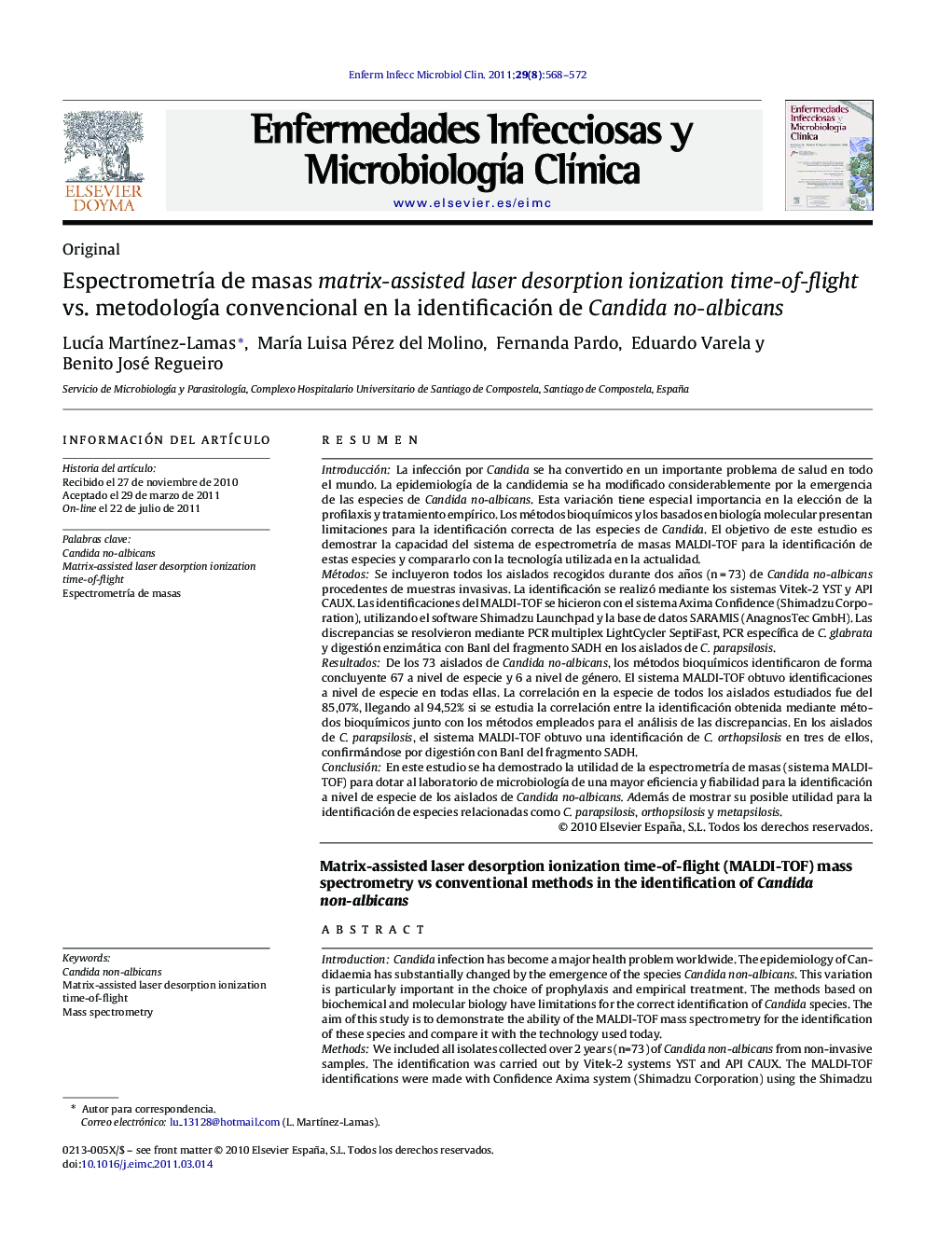| کد مقاله | کد نشریه | سال انتشار | مقاله انگلیسی | نسخه تمام متن |
|---|---|---|---|---|
| 3401414 | 1222664 | 2011 | 5 صفحه PDF | دانلود رایگان |

ResumenIntroducciónLa infección por Candida se ha convertido en un importante problema de salud en todo el mundo. La epidemiología de la candidemia se ha modificado considerablemente por la emergencia de las especies de Candida no-albicans. Esta variación tiene especial importancia en la elección de la profilaxis y tratamiento empírico. Los métodos bioquímicos y los basados en biología molecular presentan limitaciones para la identificación correcta de las especies de Candida. El objetivo de este estudio es demostrar la capacidad del sistema de espectrometría de masas MALDI-TOF para la identificación de estas especies y compararlo con la tecnología utilizada en la actualidad.MétodosSe incluyeron todos los aislados recogidos durante dos años (n = 73) de Candida no-albicans procedentes de muestras invasivas. La identificación se realizó mediante los sistemas Vitek-2 YST y API CAUX. Las identificaciones del MALDI-TOF se hicieron con el sistema Axima Confidence (Shimadzu Corporation), utilizando el software Shimadzu Launchpad y la base de datos SARAMIS (AnagnosTec GmbH). Las discrepancias se resolvieron mediante PCR multiplex LightCycler SeptiFast, PCR específica de C. glabrata y digestión enzimática con BanI del fragmento SADH en los aislados de C. parapsilosis.ResultadosDe los 73 aislados de Candida no-albicans, los métodos bioquímicos identificaron de forma concluyente 67 a nivel de especie y 6 a nivel de género. El sistema MALDI-TOF obtuvo identificaciones a nivel de especie en todas ellas. La correlación en la especie de todos los aislados estudiados fue del 85,07%, llegando al 94,52% si se estudia la correlación entre la identificación obtenida mediante métodos bioquímicos junto con los métodos empleados para el análisis de las discrepancias. En los aislados de C. parapsilosis, el sistema MALDI-TOF obtuvo una identificación de C. orthopsilosis en tres de ellos, confirmándose por digestión con BanI del fragmento SADH.ConclusiónEn este estudio se ha demostrado la utilidad de la espectrometría de masas (sistema MALDI-TOF) para dotar al laboratorio de microbiología de una mayor eficiencia y fiabilidad para la identificación a nivel de especie de los aislados de Candida no-albicans. Además de mostrar su posible utilidad para la identificación de especies relacionadas como C. parapsilosis, orthopsilosis y metapsilosis.
IntroductionCandida infection has become a major health problem worldwide. The epidemiology of Candidaemia has substantially changed by the emergence of the species Candida non-albicans. This variation is particularly important in the choice of prophylaxis and empirical treatment. The methods based on biochemical and molecular biology have limitations for the correct identification of Candida species. The aim of this study is to demonstrate the ability of the MALDI-TOF mass spectrometry for the identification of these species and compare it with the technology used today.MethodsWe included all isolates collected over 2 years (n=73) of Candida non-albicans from non-invasive samples. The identification was carried out by Vitek-2 systems YST and API CAUX. The MALDI-TOF identifications were made with Confidence Axima system (Shimadzu Corporation) using the Shimadzu Launchpad software and database SARAMIS (AnagnosTec GmbH). Discrepancies were resolved by SeptiFast LightCycler multiplex PCR, specific PCR C. glabrata and enzymatic digestion with BanI SADH fragment in isolates of C. parapsilosis.ResultsOf the 73 isolates of Candida non-albicans, the biochemical methods conclusively identified 67 to species level and 6 at the genus level. The MALDI-TOF system obtained identifications at the species level in all cases. The correlation in the species of all isolates studied was 85.07%, reaching 94.52% when the correlation was made between the identification obtained by biochemical methods and the methods for the analysis of the discrepancies. In isolates of C. parapsilosis, MALDI-TOF system obtained an identification of C. orthopsilosis. In 3 of them it was confirmed by digestion with BanI SADH fragment.ConclusionThis study has demonstrated the use of mass spectrometry (MALDI-TOF system) to provide the microbiology laboratory with greater efficiency and reliability to identify isolates of Candida non-albicans to species level. It also shows its potential usefulness in identifying related species, such as C. parapsilosis, metapsilosis and orthopsilosis.
Journal: Enfermedades Infecciosas y Microbiología Clínica - Volume 29, Issue 8, October 2011, Pages 568–572